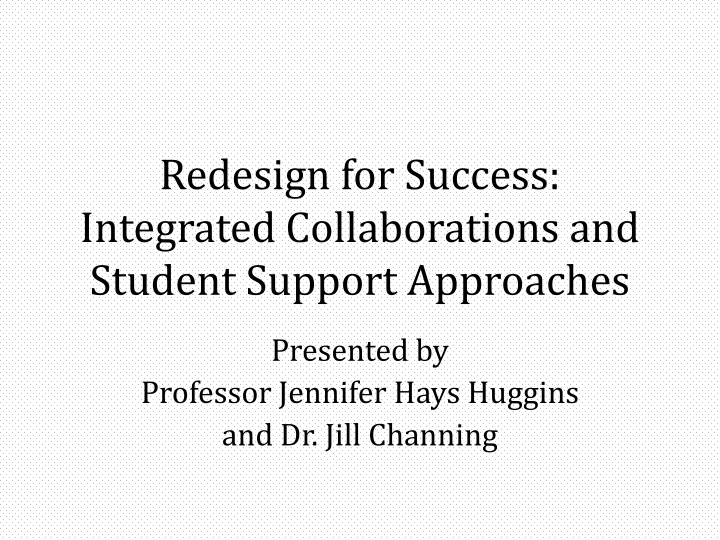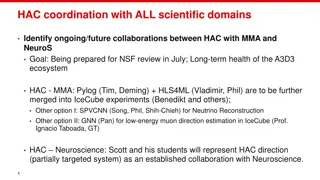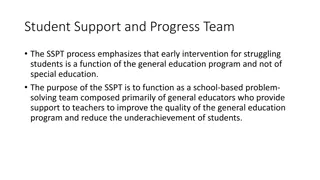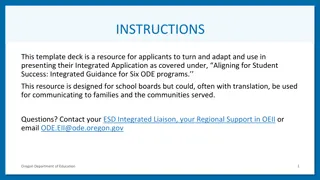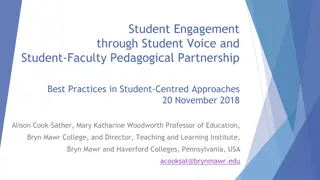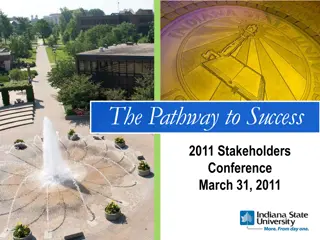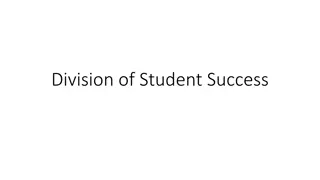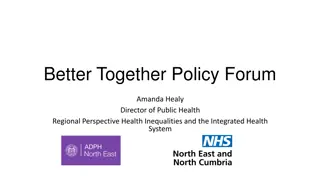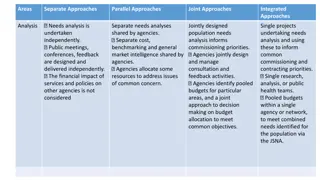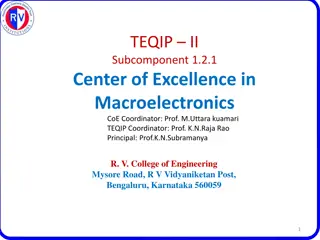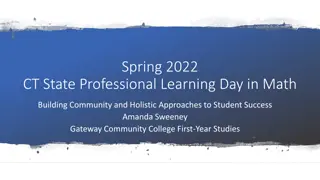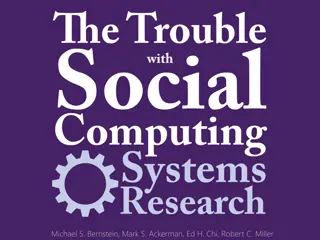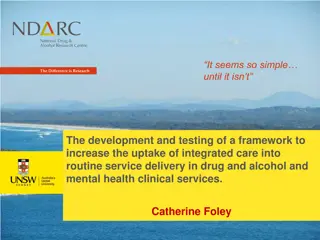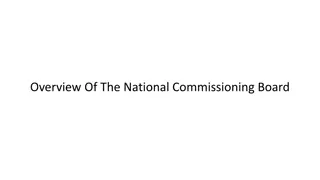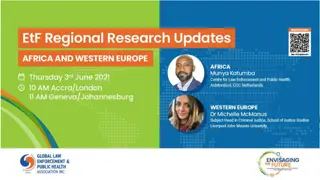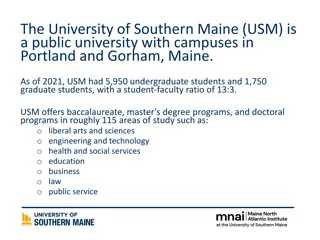Enhancing Student Success through Integrated Collaborations and Support Approaches
Professor Jennifer Hays Huggins and Dr. Jill Channing present strategies for collaborative initiatives aimed at increasing student persistence, success, and completion. The content discusses the importance of aligning college functions with student goals, reimagining programs and support services, and investing in campus-wide student supports for overall success.
Download Presentation

Please find below an Image/Link to download the presentation.
The content on the website is provided AS IS for your information and personal use only. It may not be sold, licensed, or shared on other websites without obtaining consent from the author.If you encounter any issues during the download, it is possible that the publisher has removed the file from their server.
You are allowed to download the files provided on this website for personal or commercial use, subject to the condition that they are used lawfully. All files are the property of their respective owners.
The content on the website is provided AS IS for your information and personal use only. It may not be sold, licensed, or shared on other websites without obtaining consent from the author.
E N D
Presentation Transcript
Redesign for Success: Integrated Collaborations and Student Support Approaches Presented by Professor Jennifer Hays Huggins and Dr. Jill Channing
More Than Pockets of Redesign Collaborative initiatives to create an integrative, holistic approach to increase student persistence, success, and completion.
Does this describe your college? A. Yes B. No C. Somewhat Complex degree programs Unclear goals Many choices Boxes to check off Rather than gains in skills, experiences, and knowledge related to goals http://www.roadfood.com/photos/18487.jpg
Does this describe your college? A. Yes B. No C. Somewhat Introduction to the college is the placement test Brief orientation Optional advising Focus of advising: schedule rather goals Students initiate seeking help themselves
Does this describe your college? A. Yes B. No C. Somewhat Instructors often work in isolation Pockets of innovation Few rewards and opportunities for collaboration Soft skills not emphasized in college curricula Online education increases isolation
Does this describe developmental education at your college? A. Yes B. No C. Somewhat Requires significant amount of resources Hampers students progress due to placement and lengthy sequences Has significant numbers enter but never enter college-level coursework CLASP.org
Does this describe your college? A. Yes B. No C. Somewhat College functions act in concert with and complement one another Focus on students goals Re-imagine programs and support services to align with student goals
Developmental Redesign at Kankakee Community College Not just an action project, but a campus-wide investment in student supports that translate to success.
It all began with ... Focusing on areas most relevant to college s particular vision, opportunities, and priorities three strategic directions Completion Alignment Readiness
KCCs Current Strategic Goals Create a culture of completion Promote an environment of excellence and innovation Develop career pathways in target industries Take a convening leadership role to strengthen and sustain community partnerships Redesign college foundational coursework
KCCs Foundational Coursework Redesign Redesigning developmental education structure, curriculum, and pedagogy is one of KCC's three current AQIP action projects Three-year project Expires in April 2016
The Birth of the Foundational Coursework Redesign Committee Associate deans Math, Science, and Engineering, and Humanities and Social Sciences Reference Librarian Later included: Director, Student Advisement Services Coordinator Student Success Two full-time math faculty, three full-time writing faculty, two full- time reading faculty Director, Workforce Development Act Institutional Development and Grants Research Director, Adult Basic Education
Foundational Coursework Redesign Committee s Initial Charge Research models for redesigning foundational coursework Conferences Calls to other colleges Scholarly journal articles Communication Division meetings Committee meetings Work sessions Canvas Discussion Board
Year One: Overview of Strategies Invest in professional development that will encourage necessary behaviors, attitudes, and skills to adapt to and excel through change Organize a guiding coalition and champions to support change Obtain feedback and integrate this feedback into training, collaboration, and communications Minimize and/or remove obstacles Use positions of power to prevent those who are especially resistant from stalling or derailing change
Year Two: Planning Members of the guiding coalition lead in developing implementation strategies for redesign Example: Visit division meetings to share Foundational Coursework initiatives and solicit feedback to re-work initiatives as needed Example: Cross-departmental groups map other key processes such as scheduling, the intake process, advising processes, and student support initiation process
Year Three: Implementation of Instructional Changes Redesigned Reading and Writing and Math sequences launched Embedded tutoring in mid-level developmental writing Two Learning Communities year-long Tutoring Redesign Required tutoring and online tutoring Study and success skills tutoring
Year Three: Implementation of Instructional Changes ... continued First Year College Experience course Not mandatory, but highly recommended a work in progress College and Career Readiness Alignment High schools and middle schools
Redesigned Foundational Coursework Co-requisite ENGL 1422 with ENGL 1613 Two integrated reading and writing courses Contextualized reading course Redesigned math sequences
Development of Math Pathways AS/AES Math Pathways AA/Business Math Pathway AA/Non-Business Math Pathway
Results: Co-requisite ENGL 1422 For the most part, English 1613/1422 students performed just as well as on assessments of learning outcomes as students taking English 1613 alone. They performed less well on one outcome (organization) but only by 5%.
Results: Co-requisite Student Feedback It's great and helps prep for English 1. The professor explains everything very well. She actually wants to see her students succeed. The strengths of the class are the extra class time and the extra time with the professor to help you along the way. This class was very helpful and gave great support for Engl 1. This is an Excellent course to help with English 1. The class has been very beneficial for me. It's helping a lot.
Results: Embedded Tutoring Fall 2015 WRIT-0993 Students Embedded Tutoring Students (WRIT- 0993-020) Other WRIT-0993 Students Number of Students 17 60 Successful completers ( Grade A,B, or C) Completers enrolled in ENGL-1413 (Spring 2016) Completers enrolled in ENGL-1422 (Spring 2016) 11 64.7% 34 56.7% 8 72.7% 20 58.8% 1 9.1% 1 2.9% Key Findings: Students enrolled in a section of WRIT-0993 with an embedded tutor completed the course successfully at a higher rate than students in other sections. However, zero of these students earned an A. Similarly, no student in the embedded tutor section withdrew.
Tutoring Improvements and Results Faculty requiring lab visits and including visit as part of final assignment grade Students in some classes assigned mandatory tutoring when grade dips below 75% in course Tutors visited classroom first week of school Online writing lab functional and being increasingly used Doubled tutor coverage Technology First 8 weeks SP2015 = 96 visits, SP2016 =413
Any foundational coursework re-design would only be as successful as the supports developed to help students succeed.
Year Three: Implementation of Student Supports Blurring the lines between curricular development and student advising Advising integrated in to the student experience Focused on defining goals Focus on selecting college-level program of study as soon as possible Innovative early alerts Advice Week April 2016 Joint Venture Faculty and Advising
Examples from Advising Mandatory MAPS and orientation Student planning module and goal-focused advising sessions Group advising and Advisement Week Simplified three step process to enrollment Self service tools Dropout Detective Collaboration on placement tests Cross-departmental collaboration and communication
Results: In-class Advising Students without a MAP that were not retained from FA 15 to SP 16 11% RETENTION AND MAP Students with a MAP not retained from FA15 to SP16 2% Students without a MAP that were retained from FA15 to SP16 15% Students with a MAP that were retained from FA15 to SP16 71%
Year Three: Implementation of Student Supports ... continued Success coaching Expanding to include referral from Academic Appeals Prescription success pads Challenging existing mindsets and changing the campus culture Increased cooperation and communication between and among departments and divisions
Results: Student Success Coach Fall 2015 First Time Students1 Not in Success Coach Program Fall 2015 Success Coach Program Participants Full Time Part Time Grand Total Full Time Part Time Grand Total Number of Students 102 100 202 Number of Students 205 535 740 92 (90.2%) 63 (63%) 155 (76.7%) 166 (81%) 170 (31.8%) 336 (45.4%) Number of Students Retained to Spring Number of Students Retained to Spring 20162 20162 Fall 2015 Term GPA Average3 Fall 2015 Term GPA Average3 Full Time Part Time Grand Total Full Time Part Time Grand Total By Load By Load Overall 2.46 1.66 2.06 Overall 2.41 1.19 1.53 By Gender By Gender Female 2.52 1.74 2.11 Female 2.60 1.22 1.54 Male 2.33 1.38 1.93 Male 2.27 1.16 1.52 First Generation Status First Generation Status First Generation 2.38 1.59 2.00 First Generation 2.19 1.26 1.48 Non- First Generation (25 of 202 students=12.4%) 2.71 1.84 2.27 Non- First Generation 2.57 1.14 1.57
Create A Guiding Coalition A team that oversees and champions the change Keeps the change effort on target Helps to counter organizational resistance Coalition taps people from a variety of departments with high levels of credibility, expertise in important areas, and leadership skills Give the coalition real authority Senior leadership must stay actively engaged with the group Think carefully about how team members complement one another 31
Recognize what is truly needed to redesign collaboratively. Address critical barriers Understand time and commitment to address needed changes Identify possible steps to implement change Think through intended consequences and possible ways to adapt to unintended consequences
Celebrate and build on small victories. Highlight the success of small victories, persuade stakeholders to commit to more significant change(s) Remove unnecessary processes or inter- departmental procedures obstructing change Allocate additional resources to more challenging aspects of change Significant savings for students Increased student success and completion Streamlined or better designed processes for student intakes More effective use of technology for advising and early alert 33
Address and Assuage Fear of Change Fear- psychological inertia creates anxiety that one s identity and/or sense of oneself is threatened by change Fear of the unknown Fear of failure Fear of loss Fear of leaving one s comfort zone Openly discuss strategies, weakness, opportunities, threats, and potential unintended consequences of implementing redesigning college structures, procedures, curricula, and programs
Address Obstacles and Challenges in Monthly Committee and Work Group Meetings Change Fatigue Avoid project-based approaches to change rather than systematic changes Challenge the fads phenomenon in education, coming and going Avoid change being lead top-down only
Not all Resistance is Bad: Creative Abrasion Deliberately design a full spectrum of approaches and perspectives into the organization Understand that cognitively diverse people must respect the thinking styles of others Set ground rules for working together to engage in creative processes (Leonard & Straus, 1997).
Empower Broad Based Action Create several cross- departmental groups Instructional innovations/redesign groups Partnerships with transfer/career destinations groups Professional development groups Advising group Student supports group Adjust and align redesign practices with the strategic goals/directions of the college 37
Recommendations Seek creative, collaborative, and realistic solutions Adapt strategies others have used successfully to your context Develop new strategies and processes Build guiding coalitions Depend on trusted members of the college community Seek out colleagues at other institutions and share ideas, frustrations, and brainstorming Build your network Get outside perspectives 38
Foundational Re-Design Sparked College-Wide, Innovative Dialogues
Collaborative, College-wide Process: Monthly innovation dialogues open to the entire college community and small group discussion of Redesigning America s Community Colleges
References Bailey, T. R., Jaggars, S. S., & Jenkins, D. (2015). Redesigning America s community colleges: A clearer pathways to student success. Cambridge, MA: Harvard University Press. Brim, L. (2015). How to embrace complex change. Harvard Business Review, 9, 108-110, 112. Retrieved September 22, 2015, https://hbr.org/2015/09/how-to- embrace-complex-change Buller, J. L. (2015). Change leadership in higher education. San Francisco: Jossey- Bass. Edwards, T. (2007). Shaping organizational futures through generative leadership. Leadership Abstracts, 20(2), 1-4. Klimek, K. J., Ritzenhein, E., & Sullivan, K. D. (2008). Generative leadership: Shaping new futures for today s schools. Thousand Oaks, CA: Corwin Press. Leonard, D., & Straus, S. (1997). Putting your company s whole brain to work. Harvard Business Review, 75, 110-21. Retrieved April 26, 2015, from https://hbr.org/1997/07/putting-your-companys-whole-brain-to-work/ar/1 Kegan, R. & Laskow Lahey, L. (2009). Immunity to change. Boston: Harvard Business Press. Macaux, W. P. (2012). Generative leadership: Responding to the call for responsibility. The Journal of Management Development, 31, 449-469. 41
